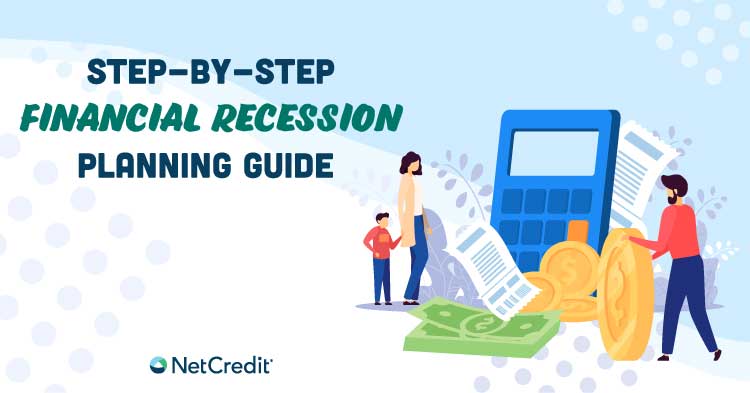If you feel behind on your savings goals, you’re not alone. Around 42% of Americans have no emergency savings. Trying to save can often feel overwhelming — and prioritizing savings can feel like you have to give up the things that make life enjoyable.
However, building an emergency savings fund isn’t about giving up the things you love. Instead, you’re building yourself a safety net, so the next time unexpected expenses pop up, they won’t throw you completely off track.
Here are a few things you can do to help build an emergency fund.
How to build an emergency fund.
1. Set a savings goal.
The first step to building an emergency fund is determining how much you need to save. Think about your personal finances — what amount of money could provide you with a sense of security? It doesn’t need to be a large amount at first. What matters is setting an achievable goal that works for you. Start small and adjust as needed. Every dollar counts when it comes to building your financial security.
2. Examine your monthly budget.
Before you start saving, it’s important to know where your money is currently going. Look at recent bank and credit card statements, and write down your monthly expenses. Separate your current spending into “needs,” “savings” and “wants” for a realistic and current snapshot. This is the first step to creating a good budget.
The “needs” are things you must pay for every month — rent or mortgage, utilities, food, etc. After accounting for your needs, you’ll allocate a certain amount of money to go to savings. Then you can move on to “wants,” which encompass things like entertainment, eating out and discretionary spending. You don’t have to give up all your “wants,” but cutting back can help you accelerate your savings. For budgeting purposes, some people follow the 50-30-20 rule for these three categories: 50% needs, 30% wants and 20% savings.
3. Find a saving strategy that works for you.
Automation. Setting up automatic transfers between your checking account and savings account can help you reach your savings goal. By automating the process, you take the decision making out of it, helping ensure your savings grow steadily without you having to think about it. Choose an amount to transfer, then pick dates that work for you and your pay periods.
Take advantage of windfalls. Sometimes, you may find yourself with a bit of extra money — like when you get a tax refund or a cash gift for the holidays, or your birthday. When this happens, try setting aside a portion of this money. Even small windfalls can add up over time.
Split your paycheck. If you receive your paycheck by direct deposit, your employer may allow you to send the money to multiple bank accounts. If they offer this option, you can set a certain percentage to be deposited into your savings account on payday. This can help you reach your financial goals without a lot of extra effort, since the money is set aside before it ever reaches your checking account.
Try a savings challenge. There are a lot of different savings challenges you can try to make saving money more fun. An example is the 52-week savings challenge. This year-long challenge encourages you to save $1 the first week, $2 the next week and so on — at the end of the year you’ll have saved a little over $1,300.
4. Prioritize your savings.
Saving up and building an emergency fund takes dedication. Treat your savings like a necessary expense, and prioritize it before spending on non-essentials. Instead of saving whatever’s left over, make saving your top priority.
Whenever you come across extra money, like loose change or any balances in your cash transfer apps, add it to your savings instead of your checking account. Even small contributions can make a big difference over time.
5. Monitor your progress.
As you work toward your goal, monitor your progress to see your savings grow. It can be highly motivating to see how far you’ve come. There are many online tools you can use to keep yourself on track. Budgeting and savings apps can help you monitor and support your journey, or you can go old school and simply write it down as you go. Whatever way you choose, monitoring your progress helps to motivate and inspire you to keep going.
6. Celebrate your success.
When you hit a milestone related to your savings goals, don’t forget to celebrate. You can reward yourself with something small and budget friendly. Celebrating your success and having something to look forward to can help you stay motivated.
Why is an emergency fund important?
Unplanned expenses always seem to pop up when you least expect them. These surprises can throw your budget off track if you’re not prepared. That’s why having emergency savings is important. An emergency fund acts as a financial safety net, so you can handle these unexpected events without derailing your financial goals. Building an emergency fund not only helps you stay financially stable, but also gives you peace of mind, knowing you’re more prepared to handle whatever comes your way.
How much should I save in my emergency fund?
Many experts recommend saving enough to cover about three to six months’ worth of living expenses. While this big of a financial cushion can provide support during situations such as job loss or big medical bills — having enough money to cover months of expenses isn’t always realistic in the short-term.
If you’re just starting out, saving $500 to $1,000 can often still provide enough money to handle financial emergencies like car repairs, home repairs or unexpected travel costs.
Where should I keep my emergency fund?
You should keep your emergency fund in a safe, accessible account. Many people create separate accounts to store their savings. Here are some common options:
High-yield savings accounts. Many banks and credit unions offer savings accounts where you can stash your money securely. A high-yield savings account allows you to earn interest at a higher rate than a traditional savings account, but some require a minimum balance or limit the amount of withdrawals you can make.
Money market accounts. A money market account is like a mix between a savings account and a checking account. You can still earn interest, but you can also make purchases with a debit card or write checks from that account. Keep in mind that most money market accounts also come with higher minimum deposit or balance requirements, and your bank can cap the number of transactions you are able to make.
Cash. If you prefer to have physical cash on hand, make sure it is stored in a safe, secure place at home or in a safe deposit box. Keep in mind that unlike an FDIC-insured bank, if the cash is lost or destroyed, there’s no way to get it back. You will also lose out on the opportunity to earn interest if you keep your emergency fund in cash instead of depositing it into a savings account.
When can I take money out of my emergency fund?
Your emergency fund is for emergencies and should only be used for unexpected, urgent expenses. Having an emergency fund gives you a safety net and protects your financial well-being. Here are a few examples of when to use your emergency fund:
- Medical emergencies
- Car repairs
- Replacing an appliance
- Home repairs
- Job loss
What to do if my emergency fund isn’t enough?
Sometimes, even the best savings plans aren’t always enough to cover the costs of a financial emergency. Here are a few alternatives to consider when your emergency fund isn’t enough.
Get help from family and friends. Borrowing money from family can be a good option because they are typically more flexible than a lender. They may not charge you interest and are often more understanding.
Look into emergency borrowing. If borrowing from your support network isn’t an option, you can explore some emergency borrowing options. Here are two common ways people borrow:
Line of credit. A line of credit is a flexible borrowing option that can help provide the funds you need in an emergency. It’s a form of revolving credit, meaning that you can borrow up to a certain credit limit, and as you repay, the funds become available to borrow again.
Installment loan. Installment loans can provide an upfront lump sum of cash to help you cover the costs of an emergency. The funds are repaid in smaller regular installments, allowing you to pay down the debt over time.
As with any financial decision, you should consider your financial situation and research lenders before you decide to borrow. Some of these options can come with high interest rates, making them an expensive option. However, they can provide much needed cash in times of need.
Take saving one step at a time.
An emergency fund is an important savings goal that can help provide a safety net for unexpected expenses. Having this financial cushion can protect your overall financial security and give you peace of mind during uncertain times. While it takes dedication to build up savings, these six steps can help make the process more manageable and help you reach your goals.
Here’s what the experts have to say.
“Treating an emergency fund like an afterthought and saving whatever’s left over at the end of the month, never works. There’s never “extra” money just lying around. The only way to make it happen is to treat it like any other bill. Set a fixed amount and move it to a separate account before you touch anything else.
Three to six months’ worth of expenses is the usual target, but you don’t have to get stuck on that number. You don’t want some unattainable target to make you feel demotivated. So just start with a goal that feels manageable like maybe just $500 or $1,000, and build from there.
Consistency and attitude are more important than the sum you set aside. Even if it’s just $100 a month, automatic transfers add up faster than you think.
Also, don’t let that money sit in a checking account where you’ll be tempted to dip into it. A high-yield savings account or even a money market account keeps it accessible but separate.”
Paul Carlson, CPA, Managing Partner
Law Firm Velocity
“Emergency savings don’t need to seem impossible to achieve. I have dealt with numerous individuals who believed that they could never scrape together enough money, yet the key is to take baby steps to begin with. A client I had set up a special savings account and was depositing a mere $10 a paycheck. Within a year’s time, she had over $500 and did not even notice.
“One other easy savings trick is to round up your purchases. One client did that on each grocery store visit and each gas tank fill-up, and those little bits of money added up in a hurry. The idea is to make it easy and automatic so you hardly even notice it is occurring.
“You do not need to hoard thousands of dollars in a single night. Simply begin, be consistent, and allow the habit to build. Life happens, and having that cushion gives you one less thing to worry about.”
Chris Heerlein, CEO
REAP Financial
DISCLAIMER: This content is for informational purposes only and should not be considered financial, investment, tax or legal advice.
Article Contributors

Paul Carlson, CPA, Managing Partner Law Firm
Paul is a CPA and the managing partner of Law Firm Velocity — a firm providing CFO and bookkeeping services for law firms.

Chris Heerlein, CEO
Chris Heerlein is CEO at Reap Financial and founder of REAP Private Client Group (RPCG), a family practice that helps private business owners, top-level executives and affluent individuals create, transition, preserve and grow their wealth over generations. He is a featured columnist for Kiplinger Personal Finance Magazine and has been featured in Fortune, Money Magazine, Bloomberg Businessweek and U.S. News & World Report.






